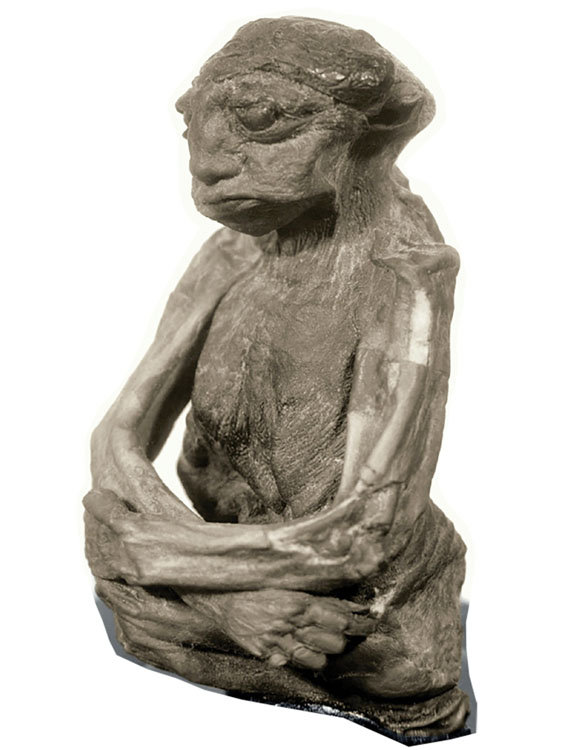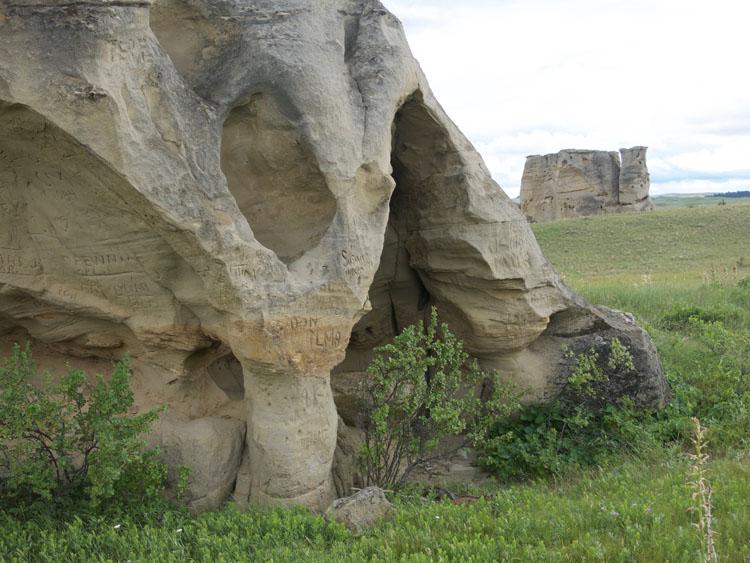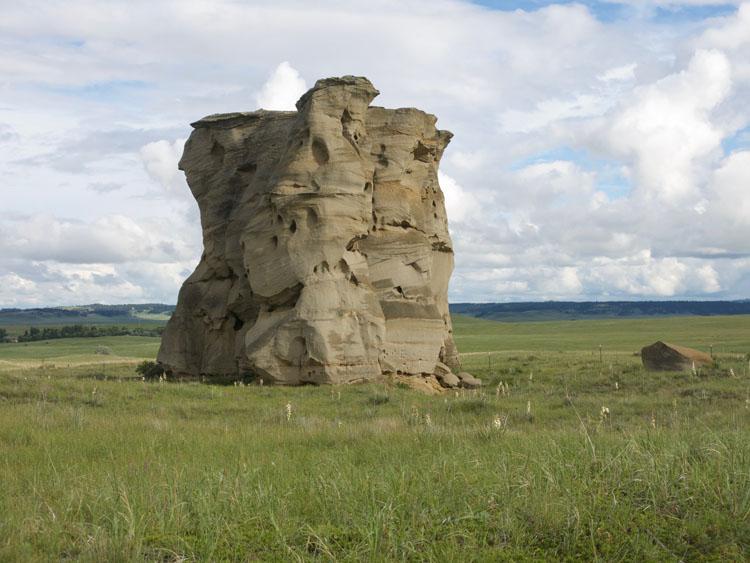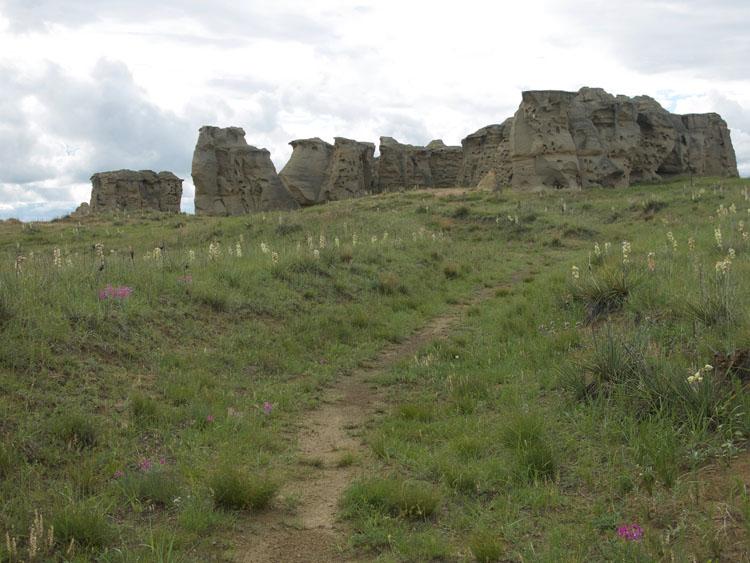MEDICINE ROCKS
A Park of Historic Proportions
Tucked away in the rolling plains of southeast Montana on State Route 7, just about 10 miles from the place where the Montana border meets both Dakotas, is a spectacular landscape of natural rock formations that has been working its magic on visitors for thousands of years. Huge lumps of sandstone, some as high as 80 feet, have been molded by wind and water into fantastical shapes, many looking like blocks of Swiss cheese that have been left out in the desert sun.
Theodore Roosevelt called it “as fantastically beautiful a place as I have ever seen.” Charging Bear, chief of the Blackfoot band of Lakota Sioux, called it the place where “the spirits stayed and the medicine men prayed.” Native Americans have long considered this a sacred place of powerful medicine, a history that gives the area its name: Medicine Rocks State Park.

The arches, tunnels, holes, and spires of the rocks had their beginnings more than 60 million years ago in a wide, freshwater river that flowed from the Miles City area southeast into a saltwater estuary located in northeast South Dakota. The sand carried by the river was deposited in underwater dunes along the way, some reaching a height of 50 feet. Over the millennia, as ice ages came and went, the weight of the sand compacted it into stone.

The monoliths have yielded some significant clues to the timeline of the area’s formation. For instance, as the inland sea receded, saltwater flowed upstream in the prehistoric river, leaving evidence behind in the rocks. A layer of crusty, gray sand sits atop the rocks, and it’s riddled with burrows made by tunneling marine worms. Wind and rain have eroded the rocks into bizarre shapes, and the strata of the dozens of layers of sand are plainly visible on their surface. In addition to the presence of saltwater, the age of the rocks has been pinpointed at 61 million years by dating the teeth of early mammals from the Torrejorian Age. Medicine Rocks is considered by many geologists to be one of the most significant deposits in North America.

Native Americans gave the rocks a different kind of significance. Archaeologists estimate that humans have been visiting the site for about 11,000 years, and several Plains Indian tribes are known to have come to Medicine Rocks to immerse themselves in the mystical qualities they ascribed to the area. Tepee rings are still visible in clearings among the sagebrush, where the Arikara, Assiniboine, Mandan, Gros Ventre, Cheyenne, Crow and Sioux camped while visiting the area. They were drawn not just by the mysterious rocks, but also by the abundance of medicinal plants like alum root, cinquefoil, and prickly pear in the area. Seashells could also be found, which were used to make jewelry and decorate items of clothing for trading. The rocks were holy, perfect for vision quests and other Native ceremonies.

Medicine Rocks was partly located on private property until the 1930s, when Carter County seized the land over unpaid taxes. In 1957, the county turned over the property to the state, and the state highway department upgraded the 320-acre site with gravel roads and installed picnic benches and fireplaces. Medicine Rocks had become a popular site for picnicking and day tripping, mostly for locals from Ekalaka and surrounding ranches. In 1965, the state Parks Division took over management of the area as a natural reserve. Medicine Rocks is a haven to a wide variety of wildlife, including mule deer, coyotes, pronghorn, red foxes, and raptors like turkey vultures and golden eagles. It’s also an attractive area for Merriam’s turkeys, which can frequently be seen skittering around the campground and flying between the rocks, searching for seeds, nuts, and berries.

The state management got the locals’ hackles up in the early nineties with a couple of unpopular moves. First, in 1990, when Fish, Wildlife and Parks attempted to establish a nightly closing time on the park, 240 people showed up at a hearing in Baker to voice their displeasure. The state backed down. A year later the state attempted to charge a three-dollar entrance fee, and again there was a sizeable backlash from area residents who frequented the park. In 1993, FWP eliminated the fee, but declared Medicine Rocks a primitive park, meaning fewer resources would be used for the site’s maintenance, including no trash pickup.
Currently Medicine Rocks State Park has an unofficial caretaker, Frank Mehling, who moved to the area in 1949 and now owns most of the land surrounding the park. While the state budget doesn’t provide much in the way of resources for upkeep of Medicine Rocks, Mehling has taken on a certain pride of ownership. He and his wife frequently go through the campground in the summer, burying the still-glowing embers of abandoned campfires. Without the funding to provide park maintenance, FWP agents in the area are aware of Mehling’s efforts and have expressed their appreciation of this good neighbor and state park steward.

There is a certain electricity in the air among the giant, surreal sculptures of the park. Far removed from the din of interstate traffic and machinery and other clatter of mankind, the Medicine Rocks make a subtle music that can be heard on the wind. As air whooshes between the rocks and whistles through the holes and caves, it contributes to an otherworldly atmosphere that makes it easy to understand why indigenous peoples sought the place out for their spiritual quests.

Of Montana’s 55 state parks, Medicine Rocks is one of the farthest off the beaten path. It’s also one of the most unusual, making it worth the two-hour drive from Miles City. On a Friday afternoon last summer, I pulled into the park under a spectacular sapphire sky on the longest day of the year. As I filled my water jug from the pump at the entrance, I noted the free camping poster on the interpretive sign. As I steered my vehicle along the gravel road between the house-sized sandstone rocks among the pines, I noticed only one campsite of the 12 available was occupied. After setting up camp, I embarked on the six-mile primitive trail that meanders through the prairie, past the biggest rocks, threading its way through sagebrush and scrub. Keeping my eye out for prairie rattlers, I marveled at the wild shapes of the rocks. It’s a gold mine for photographers, and the rocks take on an even more dramatic appearance just before sunset.

The clouds darkened as the afternoon waned, and I got back to my tent just as a summer shower swept across the plains. A typical summertime storm, this one passed over quickly, and as evening approached the sun burst out from underneath the low ceiling of dark clouds that stretched nearly to the horizon. The light slashed through the campground, making all the carved inscriptions on the rocks stand out in high relief. Songbirds warbled in full throat, and their tuneful soundtrack provided a dramatic end to a gorgeous summer day at Medicine Rocks. As I zipped myself into the tent for the night, the birds fell silent and the song of the wind in the rocks took over, whispering ancient secrets from the swooping shapes of these magnificent monoliths, these prehistoric giants that stand watch on Montana’s southeast plain, providing strong medicine to those willing to seek them out.
The Little People
The Crow name for the area is Inyan-oka-la-ka, which translates to “rock with a hole in it,” and they also believed that a race of spiritually powerful “Little People” lived among the holes and caves in the rocks. Visiting Crow members would leave offerings of tobacco, beads, or paint in order to appease the mystical Little People who were said to have great physical strength and a ferocious temperament. Mummified remains of infants found in the nearby Pryor Mountains, where the Crow thought the Little People also dwelled, were somewhat deformed with enlarged heads, which may have led to the widely believed legend among the Crow people. Little People or no, Medicine Rocks remained a holy place for the Crow, as several of their “fasting beds”—piled rock where they would lay while having their visions and dreams—have been discovered.












Leave a Comment Here